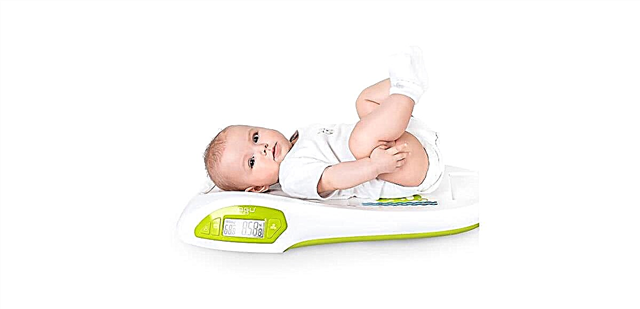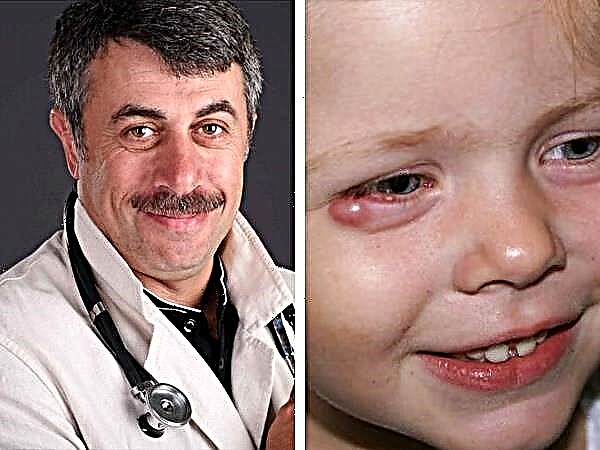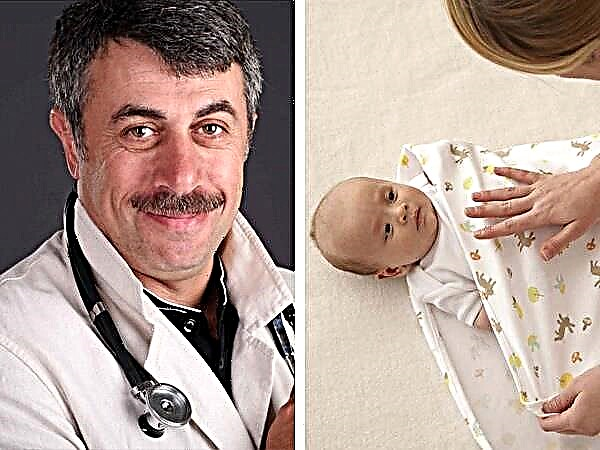
The diagnosis of sinusitis sounds threatening for most moms and dads. The attitude that sinusitis is a very dangerous disease, and it is incredibly difficult and dangerous to treat it, is firmly entrenched in the parental consciousness. Is this so, says the authoritative children's doctor, author of books on children's health and TV presenter Yevgeny Komarovsky.

What it is?
The people have a rather vague concept of sinusitis. It is often mistakenly attributed to all kinds of problems with nasal breathing, which, in fact, are allergic rhinitis or a type of sinusitis. Sinusitis is also a type of sinusitis, but only the maxillary sinuses (paranasal sinuses) are affected (inflamed). These sinuses are located on both sides of the nose in the maxillary bone. Because of the mucus accumulated in the sinuses, blockage of the narrow channel that connects them to the nose can occur, and the inflammatory process of the membrane begins.
Sinusitis is viral, allergic and bacterial, unilateral and bilateral. According to the duration of the disease - acute and chronic. By the type of pathology - purulent (exudative), necrotic (with the death of the sinus mucosa), productive (associated with the proliferation of polyps), atrophic (with mucosal atrophy).

The maxillary sinuses in newborns are very small, they grow with the child, and the normal size is acquired only by 4-5 years. It is for this physiological reason that sinusitis does not occur in children under 3-4 years of age.
Causes
There is a widespread belief that sinusitis is the cause of untreated or improperly treated ARVI, influenza and a number of other respiratory infections that are accompanied by a runny nose. Doctor Komarovsky has his own opinion on this, which is different from the standard one.
He claims that the viruses that cause ARVI also cause sinusitis, in other words, if a child inhaled a viral agent, then a foreign organism will enter not only the nasopharynx, but also into the maxillary sinuses, which are anatomically located immediately behind it and together represent a single respiratory " complex".
Thus, if a child has runny nasal discharge, then he has not only acute viral rhinitis, but also acute viral sinusitis. Komarovsky considers this statement to be true for 100% of children with ARVI. And parents must understand that this is completely normal.

The situation becomes abnormal if the inflammatory process in the maxillary sinuses persists after the main signs of a viral infection have passed... Usually, the child's body copes with the virus in 5-7 days. If the disease as a whole has receded, and the symptoms of sinusitis remain, doctors talk about bacterial sinusitis. In the acute period, a viral illness led to a large release of mucus, which accumulated in the sinuses. And bacteria began to multiply actively in it. This leads to the formation of pus. According to Evgeny Komarovsky, the probability of a bacterial complication of common viral sinusitis during ARVI is about 2-3%.

Symptoms
It is quite simple to understand that a child has sinusitis, says Evgeny Komarovsky. This ailment has rather classic and specific signs and symptoms:
- Nasal congestion;
- Impaired sense of smell, up to a complete inability to recognize and smell;
- The presence of pain syndrome in the area of the maxillary sinuses is mandatory (with a mandatory increase when the head is tilted forward);
- Weakness, feeling of "weakness";
- Increase in body temperature to 37.5-38.0 degrees;
- Headache;
- A clear feeling of "pressure", fullness in the area of the maxillary sinuses;
- Enlargement of the cheeks from the affected side, asymmetry of the face (visually noticeable).


If we are talking about chronic sinusitis (more than three weeks), the symptoms will not be as pronounced, and it will be much more difficult to recognize it.
A protracted and chronic form of the disease is characterized by persistent nasal congestion, thick nasal discharge and the usual treatment does not lend itself to redness of the mucous membrane of the eyes in the morning after a night's sleep.
With a chronic illness, the body temperature does not rise.
Allergic sinusitis also has a chronic course and is rather difficult to treat with medication. It has almost all the characteristic symptoms except for a yellow-green nasal discharge.

Diagnostics
Parents with suspected sinusitis should consult an otolaryngologist. The specialist will give a referral for diagnostic research. Usually, the ailment is perfectly visible on the X-ray of the sinuses as a darkening, the picture is complemented by a blood test with a modified formula. Komarovsky recalls that the x-ray will show not only bacterial, but also viral sinusitis, and the ENT will simply have to prescribe antibiotics to the child when making such a diagnosis based on the image.

Therefore, if there is no pain and signs of a bacterial infection, Evgeny Komarovsky advises not to take the child to an x-ray. By the way, this research method is not used anywhere in the world as the main one for diagnosing sinusitis.
Treatment according to Komarovsky
Acute viral sinusitis in a child, according to Evgeny Komarovsky, does not need special treatment. In most cases, both in adults and in children, it goes away when the immunity completely "straightens out" with a foreign agent that has entered the respiratory system and caused ARVI.
During these 3-7 days, it is important to give your child as much fluid as possible to avoid drying out the mucus in the sinuses and blocking them. It is possible and necessary to irrigate the nasal cavity with saline solutions by instilling or spraying them into the nose.
In the room, it is necessary to create favorable conditions for recovery: air humidity 50-70%, air temperature 18-20%, the air must be clean.


Complication in the form of bacterial sinusitis needs medical help and treatment. Antibiotics are used to neutralize the activity of bacteria, decongestants, rinses and drops are used to reduce edema. The child should also be given more to drink, he should breathe "correct" humidity and temperature air. The average course of taking antibiotics in the treatment of this ailment, according to Komarovsky, is 10-14 days.
There is no point in giving the child antibiotics earlier, while the sinusitis is acute and viral.
Antibacterial drugs are ineffective against viruses, and even more so they do not in any way reduce the risk of bacterial complications. Moreover, the risk of getting purulent discharge, on the contrary, increases.
There is another danger in prophylactic antibiotics for acute sinusitis. While the child takes them, bacteria begin to multiply in the maxillary sinuses, which, due to drug support, are very resistant to antibiotics. Suppurative sinusitis will still start, but it will be very difficult to respond to treatment.
The allergic form of the disease is not even treated with medicines, but by the search and elimination of the antigen that causes allergies in the child. If the allergist could not find the "culprit" of the swelling of the maxillary sinuses with the help of special tests and tests, then parents need to exclude contact with any allergens as much as possible - pollen, house dust, household chemicals, especially those based on chlorine, and also actively humidify the air in the apartment. In severe cases, the doctor may prescribe antihistamines.

About "punctures"
Such a radical method as a puncture in the inner part of the nose with the penetration of the needle into the sinus and pumping out the accumulated pus and mucus from it can be an adequate prescription of a completely adequate doctor, says Komarovsky... Folk myths and legends, which say that someone who has made a puncture once will make it more than once, does not stand up to criticism and cannot be explained by medicine.
In most developed countries with no less developed medicine, the procedure for puncturing the maxillary sinus is often used not only as a therapeutic procedure, but as a diagnostic manipulation, the purpose of which is to take a little of the contents of the sinus and find out which microbe caused this condition.

This does not mean that puncture is a measure that can be recommended to everyone. Komarovsky emphasizes that there are tough indications for the procedure:
- The nature of the inflammatory process is unknown, diagnostics did not give an answer to this question;
- Antibiotics do not work, inflammation does not decrease;
- Acute pain and high fever, treatment failure.
About folk remedies
On the Internet, you can find many folk recipes for the treatment of sinusitis. Moreover, even if mom does not go online to look for a panacea, she will most likely helpfully prompt another “effective way” by a neighbor, grandmother, or friend. Evgeny Komarovsky urges parents to refrain from treating sinusitis with folk remedies.

The viral form of the disease is not treated, either with medicines or folk remedies. And it is simply dangerous to treat bacterial by instilling onion juice and compresses with honey. The doctor warns - any heating of purulent sinusitis, any warming compresses contribute to even more severe inflammation, since bacteria multiply many times faster in a warm environment.
Komarovsky also considers common advice to breathe with this disease over hot milk or decoctions of herbs quite dangerous. The fact is that the effectiveness of vapor inhalation in case of inflammation of the maxillary sinuses is minimal, and the risk of getting burns of the respiratory tract is very high.
Tips
One of the most effective ways to prevent sinusitis is to practice singing. While singing, breathing becomes more intense.

If the house does not have a humidifier, Komarovsky recommends that parents put water in basins so that it evaporates freely, equip heating radiators with special shutter valves in order to regulate the heating intensity in winter.
With sinusitis, if there is no temperature, the child may well live a normal life - go to the pool, walk, even in winter, go to school or kindergarten, play sports.


Dr. Komarovsky will tell you more about sinusitis in the video below.



